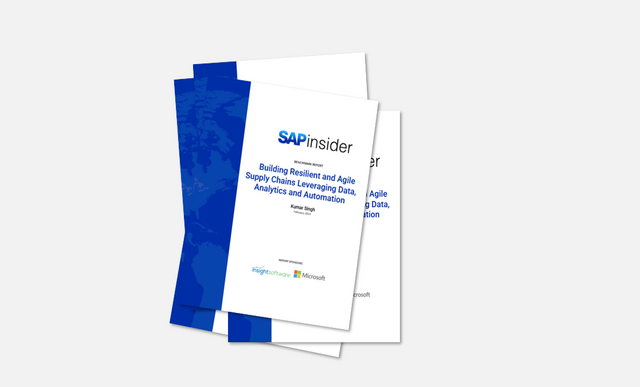Experience Management Could Take Supply Chains from Operational Parity to Brand Differentiation
By Pierce Owen, VP of Research and Publishing, SAPinsider
Many organizations do not use the supply chain or logistics management tools within SAP ERP or SAP S/4HANA as the developers intended. This misuse often leads to poorly aligned data sources that impede inventory accuracy and negatively affect company strategies. By using standard SAP tools for supply chain management (SCM) correctly, maintaining data integrity, and optimizing operations, SAP customers can achieve, at the least, parity with their competitors in unlocking business value from the supply chain. For example, SAPinsider recently wrote about how The Campbell Soup Company saved $53 million in supply chain management by optimizing the standard material requirements planning (MRP) functionality of SAP ERP with the help of Reveal Value. Similarly, we also wrote about how Johns Hopkins improved inventory management with core SAP ERP capabilities.
Obviously, optimizing standard SAP ERP functionality can have a significant financial impact on supply chain operations, but it does not create a differentiating competitive advantage. For that, organizations must look beyond standard ERP technology into the various aspects of managing customer experience.
Explore related questions
In a recent SAPinsider survey on “Digital Transformation of the Supply Chain,” 65% of leaders identified improving the customer experience as a strategic objective. Looking forward, integrations between SAP S/4HANA and other SAP applications — such as Qualtrics and SAP Integrated Business Planning for Supply Chain, as well as third-party solutions such as those that reduce cycle times for new product launches — will create new opportunities for SAP customers to use their supply chains to improve the customer experience. SAP customers can leverage the backbone of an optimized ERP system to take advantage of these integrations and use customer feedback to launch new products and fulfill demands in a timely fashion. However, the root of an optimized system starts with clean and harmonized data.
Customers Without Harmonized Data Struggle
Without harmonized data — which means having high-quality master and operational data synchronized across systems — companies struggle to get an accurate and real-time view into their inventory performance, lot sizes, and dead stock. If they cannot get accurate views of this data, they end up spending much more to manage unnecessary dead stock, and they limit their order promising and fulfillment capabilities.
The Campbell Soup Company faced this exact problem. The organization had a group of nine people processing and managing 81,000 purchase orders (POs) annually. As each effective manager of this group vacated the position, the successive manager had less experience and instructions on how to work with the MRP functionality of SAP ERP.
Ngan Lam, now Senior Manager of Supply Chain Planning Capabilities and Analytics, shared, “The person who originally implemented the functionality got promoted and left a user manual. The next guy figured it out and got promoted and left the cliff notes. The next guy moved on and left sticky notes. When his replacement left and I was hired, I got a pat on the back and a ‘Good luck!’”
No one had ever fully optimized the MRP processes, and due to lack of knowledge and inconsistent use of the functionality, the company was challenged to view the correct inventory levels. This situation led to high levels of manual intervention, a high volume of exception in the planning process, and high levels of dead stock to make up for the lack of visibility.
“We didn’t even know how to access the dashboards that showed the dead stock,” said Lam.
Customers with Harmonized Data Reduce Costs
Customers need to consolidate their SCM data in their ERP systems and harmonize that data across systems. SAPinsider research shows that companies that have taken these steps have seen reduced costs. In fact, 64% of organizations with harmonized data have seen reduced supply chain costs with their SCM and planning solutions versus 42% of all others.
In the case of The Campbell Soup Company, the business did not try to implement any new applications but instead hired SAP partner Reveal to help harmonize its data and increase the knowledge level of the entire team to maximize the value of the MRP functionality.
Reveal helped Campbell’s standardize and optimize its inventory management processes for all materials and manufacturing plants with an emphasis on cost-effective materials management through an understanding of the MRP capabilities of SAP ERP in use. Reveal also helped Campbell’s restructure the balance of power between the operational end users and the IT department to give the end users ownership of their own processes with support from IT. Utilizing the Reveal ongoing VALUE optimization (oVo) methodology, Campbell’s established clear ownership of the master data at the user and manager level to help empower the teams to optimize their materials and drive real, tangible improvements.
As a result, the material planning team at Campbell’s gained improved and accurate visibility into the company’s inventory. With this information and the newly standardized processes, the team reduced the number of exceptions, reduced the average inventory stock value by 39%, and increased the inventory turns by 38%.
“Campbell’s senior management gave us the ‘You Make a Difference’ award,” said Lam. “But that was nothing compared to seeing how we saved the company $40 million in the first year and $53 million overall since we started this project.”
This project success and process improvements resulted in not just direct internal gains but also trickled down to the customer since better inventory accuracy improves product availability.
Focus on the Customer
When it comes to managing the customer experience with the supply chain, organizations have an opportunity to design many processes with the customer’s needs first. For instance, the organization can set up its production and supply chains to accommodate many customizable features.
To meet the demand of more customized products, manufacturing and production sector companies use several product design, production, and product management technologies. For instance, most manufacturing sector respondents (versus a minority of non-manufacturing companies) use generative design or topology optimization, additive manufacturing, and a combination of edge- or cloud-based computing to process data and manage products (see Figure 1).

Manufacturing companies have used additive manufacturing, commonly known as 3D printing, for prototypes for decades, but recent years have seen a boom in using more advanced and faster additive technologies for customized and replacement parts in production environments. Customized parts can add an element of complexity to product management, but additive manufacturing makes it possible. Manufacturers can use adaptable designs and only need the ability to source the appropriate powders or raw materials for the 3D printers and the ERP system to track orders from placement to delivery.
Additive manufacturing also has strong ties to the adoption of design tools such as generative design or topology optimization because 3D printers have much wider ranges of design freedom than more traditional molding and casting or CNC reductive manufacturing. According to the data, it appears that most manufacturing companies now at least use topology optimization to speed up the design process and design lighter weight, cheaper products that use fewer materials but still fulfill or exceed performance requirements. This helps meet their driver of faster, better, cheaper products.
Meanwhile, the use of cloud and edge-based computing can help manufacturers create digital twins that process manufacturing or performance data at the source and synchronize it with product data in the cloud to monitor and manage both manufacturing processes and products in the field while feeding back performance data to improve future designs.
Using Qualtrics to survey customers, organizations can gain another source of feedback to improve future product designs. From there, they need to launch those new products faster to fulfill the customer demands represented in that feedback.
Product Launch Emerges as a Bottleneck
In one case, an American beverage company had a manual, spreadsheet-based product launch process. This company knew it needed to take a serious look at this process and consider automating it to remain competitive. The existing process consisted of a large Microsoft Excel workbook with many spreadsheets that product managers sent around to multiple departments — a process that expended many hours chasing people down to reconcile version control issues and track down siloed business objects. The master data team would then manually copy all the data from the workbook into the SAP ERP system. The team did this for all product launches, including everything from new innovations, line extensions, and label changes to new geographic launches.
The customer’s IT Director for SAP systems shared, “We called it ‘organized chaos.’”
The “organized chaos” got the job done until the customer formed a partnership with a larger company that gave it access to a larger distribution network. “After that, something had to change,” said the IT Director. “We needed to reduce launch cycle times, scale up capacity, and get more visibility for product managers and for people not directly included in the workstream.”
NPI Reduces Cycle Times
When this recently expanded beverage company decided to transform the product introduction process, it brought in SAP partner Winshuttle (now Precisely) to help. The Winshuttle team spent the first week mapping out all the product introduction workflows, identifying the biggest issues, and setting goals for scalability over the next six months, year, and five years. Then, it outlined where Winshuttle’s NPI solution could help.
The customer’s transformation project went through three phases:
- Phase One applied the NPI solution to non-drink products, including displays, clothing, and merchandise. This large-volume, low-complexity project only took one month for a quick win.
- Phase Two extended the solution to cover raw materials such as packaging and drink ingredients. This phase included creating purchasing data and source materials business objects and took three months.
- Phase Three automated the entire product launch process with NPI and retired the Excel workbook. This meant overhauling the entire process of creating and extending finished goods, semi-finished goods, raw materials, bills of material, purchase information record, and source lists. The overhaul of the process in this phase took six months.
At the conclusion of the project, the customer had a single landing page to kick off product launches with role-based access to certain forms and real-time integration with the SAP ERP system. It went from siloed data collection in spreadsheets to an automated, collaborative, and integrated workflow. This significantly reduced cycle times for new product projects and improved visibility for product managers. Also, the master data team could now hand data ownership over to the business users.
“The NPI solution allows repeatable processes to collect the right data at the right time from the right people,” said the IT Director. Now, this organization can introduce and launch products faster than ever before to better meet customer demands.
Learn More
These customer examples demonstrate how members of the SAP ecosystem can use supply chain management enhancements to improve the customer experience and differentiate their brand. By leveraging the SAPinsider community, SAPinsider research, and resources from SAP, SAP customers are well positioned to get the most business value out of their SAP ERP system and to differentiate by improving the customer experience. Learn more by reading research from SAPinsider and by visiting SAPinsider Online.




